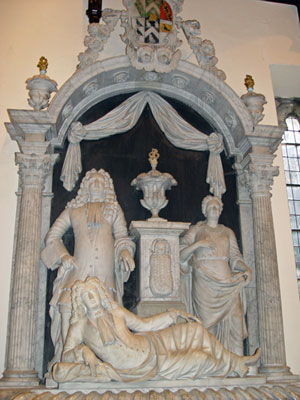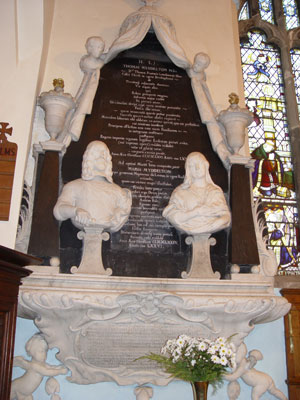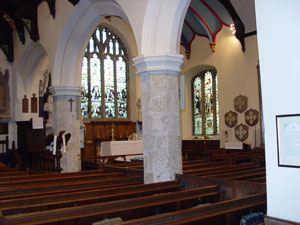The Parish Church of St Mary, Chirk
|
The Myddeltons of Chirk Castle descend from Rhirid Flaidd, Lord of Penllyn who died in 1207. Sir Richard Myddelton, (1559 - 1631), the elder, who purchased Chirk Castle in 1595 for £5,000, was a son of Richard Myddelton of Denbigh and elder brother of Sir Hugh Myddelton of New River fame. Sir Thomas was a member of the Grocers' Company, a member of Parliament and a founder member of the East India Company and Lord Mayor in 1613. It is his son Sir Thomas Myddelton, (1586 - 1666), the younger, and his wife Mary Napier who are commemorated by the earliest of the Myddelton memorials on the east wall on the north side of the pulpit. This Sir Thomas was prominent as Sergeant Major General of the Parliamentary forces in North Wales in the Civil War. His zeal for the cause moderated and after the execution of Charles I abated, and in 1659 he joined the Cheshire Rising proclaiming Charles II as king in Wrexham market place. As a result General Lambert besieged Chirk Castle. At the Restoration Sir Thomas is said to have received £60,000 to recompense his losses and his son was created a baronet. The companion monument on the south side commemorates Elizabeth Wilbraham, (d. 1675), wife of Sir Thomas Myddelton, (1651 - 1683), the second baronet. Elizabeth died a few days before her infant son and is represented as a young mother suckling her babe. These two monuments are the work of the celebrated statuary John Bushnell who could 'either be extremely good or maddeningly bad.' There is a reference in the Chirk Castle Accounts - 1676 Dec 21 Payd John Harrys, for his journey to Weston for my ladye's picture, for Bushnell the stone cutter to draw a pattern to make her monument at Chirke. 0.1.6.
1722 March 20 Pd John Edward Clarke of Chirke, for takeing up and levelling ye north chancell in ye Church after ye erecting os Sr Richard's monument. 0.2.0 The monument commemorates Sir Richard Myddelton, (1655 - 1716), third baronet, his wife Dame Frances with her infant daughter, a chisom babe, and their only son Sir William Myddleton, fourth baronet whose sudden death in 1718 led to his inclusion in the group after the monument had been commissioned. Sir William was succeeded by his cousin Robert Myddelton, (d.1733) who in turn was succeeded by his brother John Myddelton (d.1747). The last male heir was his son Richard (d.1795). In 1801, Charlotte, daughter and co- heiress of Richard Myddelton married Robert Biddulph of Ledbury who assumed the surname of Myddelton from whom is descended the present owner of Chirk Castle Lieutenant Colonel Ririd Myddelton, M.V.O. (now in the care of the National Trust). The memorials to the Myddelton-Biddulphs are to be seen on the east wall (north) and on the north wall of the chancel both in stone and stained-glass. It will have been noted that from time to time the memorials to the Myddelton and Trevor families have changed their positions. From 1620 to 1630 there was a dispute between the two families which was taken to the Court of the Marches of Wales. The Myddeltons, then newcomers to the parish, had increased their influence by the purchase of the rectorial tithes in 1614 and in right of such were responsible for the ordering and repair of the chancel. The Trevors had previously enjoyed immemorial right and resented what they considered an intrusion of their privileges. Archdeacon Thomas summarised the quarrel which is of interest in its description of the arrangement of the chancel in the early seventeenth century. 'Sir Thomas Myddelton had claimed
as lay rector the right to set up three pews in the chancel in 1620, and
had given permission to Sir Edward Trevor to erect one for himself and
family; and had also removed, c.1622, from the south side of the chancel a
large strong chest for the keeping of the ornaments, vestments and other
treasures of the church to a more convenient place, and had made another
pew for himself and friends in its place, but had been disturbed in the
use of it by John Yale and other dependents of Sir Edward; and he now
required Sir Edward to set forth what right he had in and to the chancel,
which of right only belongs to the rector. To this Sir Edward replied that
he and his ancestors did usually sit in the south chancel to hear divine
service as appertaining to the ancient houses in Brynkynallt; that the
ancient seats in the said chancel belonged to the gentry and their houses,
which was the case for the most part throughout Wales; that their burial
place, and none other, was on the south side of the chancel; that the
Trevors' Coat of Arms was in the south window above the said seat, and had
been there time out of mind, and that in all likelihood the Trevors had
built the Church. The dispute was eventually settled. The family vault of the Myddeltons is under the south chancel and the Trevor vault is at the east end outside. |
© The Parish Church of St Mary, Chirk
Website:- http://www.stmaryschirk.org.uk/
| Click on the town name below to visit other areas of Wales or Here for Map | ||||||
| Aberaeron | Aberdovey | Abergavenny | Aberystwyth | Amlwch | Bala | Barmouth |
| Beaumaris | Beddgelert | Betws-y-Coed | Brecon | Builth Wells | Caernarfon | Caldey Island |
| Cardiff | Cardigan | Carmarthen |  |
Chepstow | Chirk | Colwyn Bay |
| Conwy | Crickhowell | Denbigh | Fishguard | Flintshire | Harlech | |
| Haverfordwest | Holyhead | Llanberis | Llandrindod | Llandudno | Llangollen | |
| Machynlleth | Newport | Newtown | Porthcawl | Porthmadog | Pwllheli | Rhayader |
| Rhyl | Ruabon | Ruthin | Saundersfoot | St Asaph | St Davids | Swansea |
| Tenby | Welshpool | Wrexham | Photos | Old Photos | Chester | Oswestry |
Copyright © Mark Redfern 1998 -


 The
Chancel Memorials - The Myddeltons of Chirk Castle
The
Chancel Memorials - The Myddeltons of Chirk Castle
 The
third monument on the south wall of the Church is the work of Robert
Wynne, statuary of Ruthin. Originally the monument was erected in the
north chancel, probably where the pulpit now stands.
The
third monument on the south wall of the Church is the work of Robert
Wynne, statuary of Ruthin. Originally the monument was erected in the
north chancel, probably where the pulpit now stands. That in the upper end of the church, the chancel did, therefore extend
throughout both the north and south aisles, until Sir Thomas Myddelton
erected certain pews; that the sexton, strangers and children were
permitted to sit at their pleasure on the large and strong chest, and that
anciently time out of mind, there was an ancient settle of wood in the
nature of a chest, with lids opening above, to put books into, upon which
settle or chest he and his ancestors usually sat to hear divine service
without contradiction. That there stood a large standing high desk before
the said settle for to hold their books, which said settle and desk, after
the removal of Sir Edward's father to the parish of St. Martin's there to
dwell and during the time Sir Edward was employed in the late Queen's and
King's service and wars in foreign countries, were removed by Sir Thomas
Middleton and Robert Lloyd, now vicar, of purpose to extinguish his right;
and about ten years past (1620), he, Sir Edward, set up a pew in the said
chancel in his own right by the assent of the bishop and the chancellor of
St. Asaph, by removing a pew that the vicar had placed there a year before
at the charge of the parish; and about nine years ago, "seeing a
fayre piece of Wenscott," set up in the east end of the said south
chancel, being above the Communion table, with a seat before it; and
within a short time after, "a wainscot pew", of the same or like
work, set in the upper end of the said chancel adjoining to the said
wainscot; he did a short time after "demand of the Vicar by whose
authority it had been done".'
That in the upper end of the church, the chancel did, therefore extend
throughout both the north and south aisles, until Sir Thomas Myddelton
erected certain pews; that the sexton, strangers and children were
permitted to sit at their pleasure on the large and strong chest, and that
anciently time out of mind, there was an ancient settle of wood in the
nature of a chest, with lids opening above, to put books into, upon which
settle or chest he and his ancestors usually sat to hear divine service
without contradiction. That there stood a large standing high desk before
the said settle for to hold their books, which said settle and desk, after
the removal of Sir Edward's father to the parish of St. Martin's there to
dwell and during the time Sir Edward was employed in the late Queen's and
King's service and wars in foreign countries, were removed by Sir Thomas
Middleton and Robert Lloyd, now vicar, of purpose to extinguish his right;
and about ten years past (1620), he, Sir Edward, set up a pew in the said
chancel in his own right by the assent of the bishop and the chancellor of
St. Asaph, by removing a pew that the vicar had placed there a year before
at the charge of the parish; and about nine years ago, "seeing a
fayre piece of Wenscott," set up in the east end of the said south
chancel, being above the Communion table, with a seat before it; and
within a short time after, "a wainscot pew", of the same or like
work, set in the upper end of the said chancel adjoining to the said
wainscot; he did a short time after "demand of the Vicar by whose
authority it had been done".'